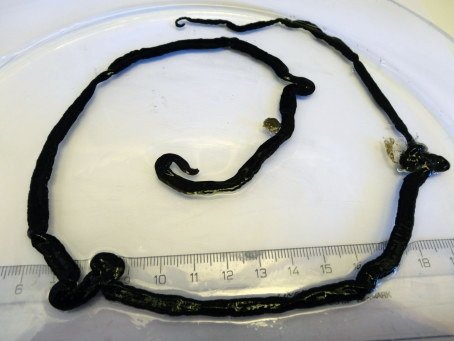
Think of it like a favorite coffee shop. If the air quality gets bad or the food isn’t fresh, you’d probably think twice about hanging out there. In a similar way, pollution can impact the habitats of bootlace worms, leading to broader effects on the ecosystem. So, let’s take a closer look at how these wriggly wonders are affected by pollution and what that means for their future.
What Are Bootlace Worms?
Bootlace worms, scientifically known as *Lineus longissimus*, are fascinating creatures found predominantly in the waters around the British Isles and parts of Europe. Imagine a silky thread that can stretch endlessly; that’s pretty much how they look! They can be a mix of vibrant colors, typically yellow or brown, and often dwell in the sea bed, hiding among rocks or in the sand.
These worms are not just long; they are also quite resilient. Despite their delicate appearance, they have adaptations that allow them to thrive in different marine environments. Bootlace worms are *predators*, feeding on small crustaceans and other marine life, which makes them important players in the food chain.
But here’s where it gets interesting: just as our health can be affected by the air we breathe, bootlace worms can also suffer when pollution infiltrates their habitat.
How Pollution Affects Marine Life
Pollution can come from various sources—everything from industrial waste to plastic debris. Each type of pollution has distinct effects on marine ecosystems. For instance, chemicals like heavy metals and pesticides can accumulate in the tissues of marine organisms. This phenomenon is known as *bioaccumulation*, and it can disrupt the delicate balance of marine life.
You might be wondering how this directly impacts bootlace worms. Well, when pollution seeps into the ocean, it can lead to changes in water quality—like reduced oxygen levels or increased toxins. This not only makes it harder for bootlace worms to survive but could also affect their ability to reproduce. If the water isn’t healthy, neither are they!
Furthermore, as pollution continues to enter marine environments, it can disrupt the entire food web. If bootlace worms struggle to thrive, it’s not just them that suffer; the species that rely on them for food can also face challenges.
Specific Pollutants and Their Effects
Let’s look at some specific pollutants that can harm bootlace worms. Here are a few to consider:
- Heavy Metals: These pollutants can come from industries and often accumulate in marine sediments. Bootlace worms feeding on contaminated sediment can ingest these metals, leading to health issues.
- Pesticides: Runoff from agriculture can introduce harmful chemicals into ocean waters. These pesticides can disrupt the nervous systems of marine organisms, including bootlace worms.
- Microplastics: Tiny plastic particles have become prevalent in oceans due to human activity. Bootlace worms can mistake these particles for food, leading to ingestion and potential digestive issues.
Each of these pollutants presents unique challenges to bootlace worms, making it crucial to address pollution for the sake of their survival.
The Impact of Climate Change
Climate change isn’t just affecting the weather; it’s also wreaking havoc on marine ecosystems. Rising ocean temperatures can create a more acidic environment, which can stress marine life, including bootlace worms. Warmer waters can lead to changes in food availability and breeding patterns, putting additional pressure on these creatures.
Here’s the thing: bootlace worms rely on a specific range of temperatures and conditions to thrive, and climate change can shift that balance. When temperatures rise, it can lead to habitat loss and make them more susceptible to diseases. This is like trying to grow your favorite flowers in the wrong season—no matter how much you care for them, the conditions just won’t support their growth.
Research and Conservation Efforts
Scientists are actively researching the effects of pollution on bootlace worms to better understand their resilience and adaptability. By studying their behavior in polluted environments, researchers can gain insights into how to protect these creatures and the ecosystems they inhabit.
Conservation efforts are vital. Initiatives to clean our oceans, reduce agricultural runoff, and regulate industrial waste are all geared towards creating a healthier environment for marine life, including bootlace worms. Every little effort counts—like small ripples in a pond, they can lead to bigger changes over time.
What Can We Do to Help?
You might be wondering how you can contribute to the conservation of bootlace worms and marine ecosystems. Here are a few simple actions you can take:
- Reduce Plastic Use: By using reusable bags and containers, you can help minimize plastic waste.
- Participate in Clean-Up Events: Join local beach clean-ups or other community efforts to remove trash from marine environments.
- Support Sustainable Practices: Choose products that are sustainably sourced and support companies focused on environmental responsibility.
Small actions can lead to significant impacts, and collectively, we can help ensure the survival of bootlace worms and the health of our oceans.
Final Thoughts
The question of whether bootlace worms are affected by pollution is more than just a scientific inquiry; it’s a matter of our responsibility towards the environment. These remarkable creatures are indicators of ocean health, and their wellbeing reflects our own impact on the planet. By understanding how pollution disrupts their lives, we can work towards a healthier future for all marine life.
So, next time you think about bootlace worms, remember they’re more than just fascinating creatures. They’re vital components of our ecosystems, and it’s up to us to protect their homes.
